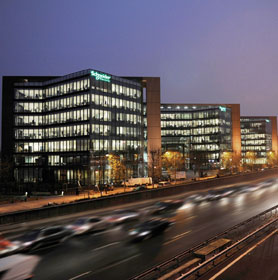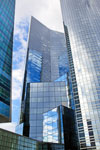

Buildings are one of the world's largest energy consumers, being responsible for 40% of the world’s annual energy consumption.
A technological showcase
Schneider Electric has a complete range of technical solutions and services for smart management of buildings and optimisation of their use. The company’s global headquarters in Paris, The Hive (Hall de l’Innovation et Vitrine de l’Energie) has been fitted with the latest technologies and is a showcase for its offerings. Opened in 2008, the Hive demonstrates that it is possible to make significant energy savings in a short space of time. Using Schneider Electric solutions, the building’s average annual consumption per m² has fallen from 150 kWh in 2009 to 78 kWh in 2012, a reduction of 47%.
A management system for integrated buildings

Today's buildings house an ever-increasing number of networks: electricity distribution, IT, lighting management, control of HVAC functions and security monitoring. There are numerous applications, generating endless protocols and requiring communication between many different parties. The only way to optimise the management of a building is to have all these systems communicating. Convergence enables systems that have been designed independently to talk to each other via an information system, and all these open systems and their interactions can be managed as a single unit.
In order to optimise management of the Hive, Schneider Electric has made all the systems in this 35 000 m² building talk to each other. All the building's energies and systems share the same architecture, EcoStruxure, and they are all managed by a shared control system, the Building Management System (BMS). The building is equipped with Schneider's Continuum BMS, which enables integration of all systems – HVAC control-monitoring, video surveillance, access control, intruder detection, electricity and heat meters – through a shared IP3 network.
Increased comfort for occupants
Because it can communicate via open, recognised protocols such as BACNET and LON, the Continuum system also enables interoperability between different items of office equipment, such as blinds, lighting and air conditioning. Individual occupants can regulate their own working environments whenever and however they like, using simple, wall-mounted or wireless remote controls to adjust light, temperature and direct sunlight. Behind this user-friendly interface lies a powerful distillation of technology and know-how, a place where sub-protocols such as DALI, LON, KNX, MODBUS and MBUS come together and communicate with one another.
Guaranteeing the security of the building and its residents
The Hive is equipped with three security solutions implemented by Schneider Electric: access control, intruder detection and video surveillance. The building has a system of 45 Pelco5 cameras with night vision capability. Using digital technology, video surveillance enables Schneider Electric to display, record and, if need be, use images from these cameras. Pelco Endura, developed by Schneider, is a distributed digital video security system operating on a TCP/IP architecture network. It can be used to monitor the entire data flow from literally any connection point on the network.
You can't manage what you can't measure
The entire Hive is equipped with electricity and heat meters located as close as possible to energy-consuming equipment. Every 10 minutes, all these consumption readings are transferred to the energy monitoring portal, StruxureWare Energy Operation7, which generates performance reports and identifies any malfunctions. This software can automatically process requests for action received from the building's occupants via a web portal that can be accessed from any tablet, cellphone or PC. These might relate to air conditioning settings, for example, or reporting a water leak.
Optimising the occupancy rate
To optimise the Hive's occupancy rate and the surface area rented out, occupancy rates are continually monitored. Schneider Electric has added the Gilif solution to its BMS. This uses anonymous badge holders equipped with RFID chips. When these chips are detected by the sensors already installed
in the Hive, their holders communicate with a central localisation server. This information makes it possible to fine-tune the surface area that is actually occupied and measure the difference between predicted occupancy and actual use.
Raising awareness among the building's residents
Involving employees in energy efficiency programmes is a key issue. An intranet site allows residents to follow changes and check results for energy consumption, CO2 concentrations, water consumption, garbage, air quality, humidity levels and temperature. The StruxureWare Energy Operation portal is a crucial tool for achieving this objective, since it pushes consumption data for each floor, department and building. Display modules in communal areas provide the public with information about the building's energy consumption and advocate good practice.
Charging stations for electric vehicles
Because electric mobility will be an integral part of tomorrow's smart cities, Schneider Electric has already started providing clean transport solutions for its employees. Parking spaces have been equipped with three dual stations for regular charging, and one fast-charging station for seven electric vehicles. Residents with their own electric vehicles can recharge them at two additional dual charging stations.
In this area, too, the BMS plays a decisive role. As a system, it must make sure it can supply the power needed to recharge vehicles while at the same time securing the building's electricity supply on the most advantageous terms possible.
Integrating renewable energies
Implementing solutions for renewable energy production in buildings will be part of the construction industry's contribution to the future energy mix and Schneider Electric has fitted the Hive with a 90 m² photovoltaic solar awning that uses the company’s own technology.
An approach based on certification
Active certification of the Hive is part of the Group’s continuous process for improving the environment. The ISO 50001 standard, created in June 2011, defines the requirements for the design, implementation, maintenance and improvement of energy management systems. Its aim is continuous improvement of the energy performance of commercial and industrial buildings, optimisation of their use and reduction of their operating costs. Schneider Electric's headquarters was the first building in the world to be awarded ISO 50001 certification.
BREEAM In-Use is an assessment program which originated in Britain. Its aim is to help site managers reduce energy costs and improve the environmental performance of existing buildings. In 2012, the Hive was the first international building to be certified Outstanding (6 stars). This new certification goes beyond energy-efficient solutions (energy, water and waste management) implemented in the building.
The Hive also obtained other important certification. ISO 40001 relates to environmental management – what a business does to minimise the damaging effects of its activities on the environment and continually improve its environmental performance. At the end of 2012, 63% of Schneider Electric's employees were working on ISO 14001 certified sites.
A showroom for discovering Schneider Electric
The International Customer Lounge (ICL) has had more than 22 000 visitors.
Interactive displays demonstrate the potential of networking energy sources and of using renewable energies for more responsible and efficient energy management. It also showcases some of the company’s latest technological innovations. The ICL illustrates the Group's five areas of technological expertise, and the solutions provided by EcoStruxure, the proactive energy management architecture developed by Schneider Electric for its own customers and their markets.
For more information contact Ntombi Mhangwani, Schneider Electric, +27 (0)11 254 6400, [email protected], www.schneider-electric.com
| Tel: | +27 11 254 6400 |
| Email: | [email protected] |
| www: | www.se.com/za/en/ |
| Articles: | More information and articles about Schneider Electric South Africa |

© Technews Publishing (Pty) Ltd | All Rights Reserved